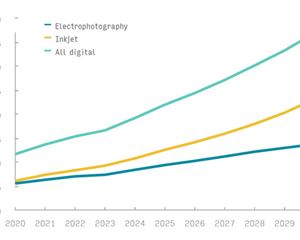4D printing market to grow by 43%
A recent report released by Market Research Future projects that the global 4D printing market would increase from USD 510-million by the end of 2030 at a CAGR of 43.1%. 4D printing, commonly referred to as 4-dimensional printing, adds the dimension of transformation over time to the 3D printing process by fabricating three-dimensional things through the sequential layering of material according to computer programming.
22 Aug 2022 | By Rahul Kumar
A more sophisticated 3D printing known as 4D printing allows the component to change shape when exposed to dampness, heat, or other environmental stimuli.
According to the report, in the future, the necessity to lower manufacturing and processing costs due to intense competition is anticipated to play a significant role in propelling the growth of the worldwide 4D printing market. Based on 3D printing technology, 4D technology suggests a new business model meets the present market's needs by reducing the need for capital, inventories, and time-to-market and increasing company efficiency.
Today, various technologies are combined to help improve the performance of 4D printing materials. Some of the technologies are multi-material 3D/4D printing, optimisation/simulation software improvements, and materials science developments. With these abilities’ help, many materials can now be fully programmed to alter their look, form, or other attributes to suit their needs. These innovative materials, which enable previously unheard-of self-transformation, programmable actuation, and sensing capabilities from primary material, include carbon fibre, customised textile composites, and printed wood grain.
Between 2021 and 2030, the 4D printing industry is anticipated to expand at a CAGR of 43.1%. The programmable carbon fibre market is anticipated to contribute the most to the industry in 2020, accounting for 62% of the total market. The market is expected to have phenomenal growth over the projected period because, in the researcher's opinion, the increase in the adaptation of highly advanced technology due to the environment's rapid changes is the primary critical element for market growth. In the upcoming years, the introduction of new goods and a broad range of advancements are projected to further the market's expansion.
The automobile, clothing-utility, aerospace and defence, construction, healthcare, and others comprise the worldwide 4D printing market. Many research institutions, including NASA, consider utilising 4D printing technologies to create new goods. NASA plans to use 4D printing in April 2017 to create a type of chainmail to shield the spacecraft from meteorites.
Due to the development of 3D printing technology and the widespread use of 3D printing in this region, the North American segment is anticipated to dominate the worldwide 4D printing market. This can be attributed to the conception of 4D technology, particularly in the United States, and the increasing attention paid to technological breakthroughs. Scientists are concentrating on creating 4D material that can adapt to various climatic conditions as the region invests more money in R&D.
Due to technological advancements, the European market is regarded as the second-largest market for 4D printing. By the conclusion of the projection period, the Asia-Pacific region’s 4D printing market will have expanded significantly.
By 2025, the Asia-Pacific industry is anticipated to overtake the North American market. The market expansion in the Asia-Pacific is anticipated to be fuelled by technological developments and an increasing focus on creating new goods, creating profitable prospects for the top players in this sector. However, the high starting cost is anticipated to hamper the market expansion over the upcoming years.
For details, please visit Market Research Future.












 See All
See All